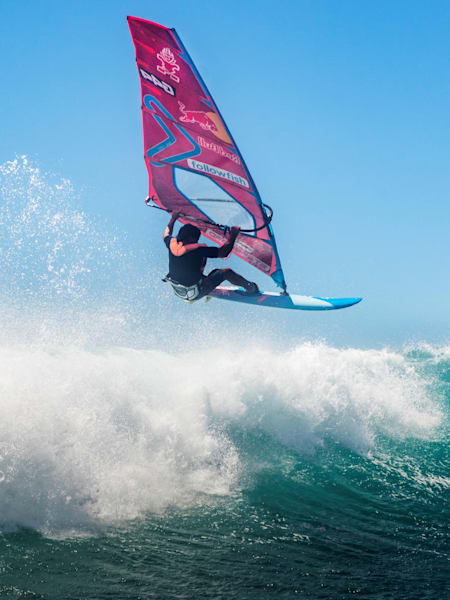The ability to problem-solve is pretty handy when life takes an unscripted turn. But it’s absolutely necessary when dealing with the most unpredictable beast of them all: mother nature. And that’s an almost daily occurrence in windsurfer Philip Köster’s 9-5.
The 'colleagues' Köster spends most of his time with are the oceans and the winds. For many just one force of nature wouldn’t be the easiest to work with – let alone two – but Köster manages quite well. In fact, he’s a world champion at it. And his ability to almost instantaneously process and solve the complex puzzle of the surf is one of the main reasons why. We know that because Köster’s strengths are in thinking, and we know that because of the Red Bull Wingfinder test.
Köster’s Red Bull Wingfinder results tell us he is a hands-on learner. This means he thrives when learning on the job and deals with problems by diving right in – you don’t need us to tell you how important those traits are for his chosen profession. But the hands-on learner isn’t the only type of thinker out there. You could also be more agile or analytical, a balanced learner or your strengths may be more in intuition.
But what do those mean? Let’s break it down for you.
1. Agile
An agile thinker excels when faced with complex problems. Using logic and focusing on objectivity, you're able to process a situation, absorb all the information around it and quickly spot the right solutions. And because of those abilities, the agile thinker is also a fast and always-on learner.
However, those traits can sometimes get you into a spot of bother. Agile thinkers have the tendency to only stick with ideas that have been rigorously tested and researched, and rarely take a chance on the unpredictable – even when it might be the best bet. And because you can quickly process and resolve issues, as an agile thinker you may often race ahead of those in your team who don’t have similar strengths. If that’s the case, you’ll get the best results if you pause and wait for them to catch up and give their input.
2. Analytical
Logic is the best friend of an analytical thinker. You're very good at solving complex problems, and prefer to assess the situation before you jump in. These traits are why fencer Max Heinzer has risen to the top in a sport that requires patience and well-thought strategy. For Heinzer, and all analytical thinkers, the approach to work is methodical and all different options are weighed-up before getting to the heart – or head – of the problem.
However, for analytical thinkers if an option lacks reasoning behind it then it often isn’t considered. But the good thing is this can be counteracted if you team with the right people. The different approach of a hands-on learner – like Köster – will give some interesting results. And we’ll get into why shortly.
3. Balanced learner
A balanced learner is exactly that. When dealing with a problem, you combine logic and rationality with the intuition learned from past experiences. This means that while you can remain objective on the task at hand, you are able to trust your instincts when making a decision. And because of that you’re not afraid to accept that the most simple solution may be the right one.
As a balanced learner, your thinking style lends itself well to different activities, so don’t become too comfortable using just one approach – use the abilities at your disposal.
4. Hands-on learner
Hands-on learners have a practical and straightforward approach to problem-solving. Like Köster, you use common sense and past experience to guide you towards the best solution. As the name suggests, you’re at your best when learning on the job.
However, this trait can be problematic when faced with complex issues that require you to take your time and analyse the full picture. These scenarios often don’t require an instantaneous response, so instead break them down into manageable chunks.
5. Intuitive
An intuitive thinker is driven by common sense. You follow your experience and natural instincts and, because of that, have a real knack for making quick decisions well. Intuitive thinkers tend not to overthink or over-rationalise issues, instead keeping clear judgement.
Intuition is a real strength, but relying on it too heavily can be an issue. Complex situations you haven’t encountered before can make that very clear, as you may make the wrong call. Instead slow down, take time to analyse the situation and you’ll achieve the best solution.
And there we have it. The five types of thinker. Now it's time to figure out which you are. Take the Red Bull Wingfinder test today to find out. You never know, your strengths may not even be in thinking at all. Remember there are 25 strengths across four key areas (thinking, creativity, drive and connections). So what are you good at?






